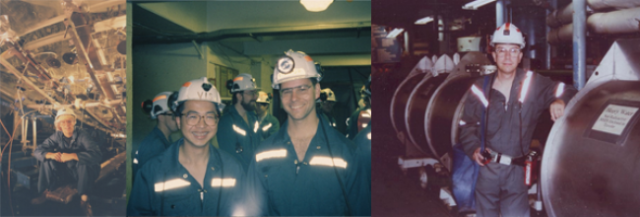Oct 8 2015
UBC physicist and Sudbury Neutrino Observatory researcher Chris Waltham on the SNO’s quest, a colleague’s Nobel Prize, and UBC’s footprint in international neutrino research.

Arthur B. McDonald (Art to all who know him) wins the 2015 Nobel Prize in Physics "for the discovery of neutrino oscillations, which shows that neutrinos have mass". Art was the leader of the Sudbury Neutrino Observatory collaboration, which made the key measurements and included members from the UBC Department of Physics and Astronomy.
Neutrinos may be the most abundant elementary particle in the universe. Chargeless, pointlike (as far as we know) and long thought to be massless, they should be the easiest particle to understand. However, in the early 1980s, all the available data on neutrinos just didn’t fit together. In particular, the apparent lack of neutrinos coming from the Sun became known as the “Solar Neutrino Problem.” Between 1993 and 1998, SNO - Sudbury Neutrino Observatory – was built to solve this problem, and data taken at SNO between 1999 and 2003 did just that by showing that the cause of the deficit was a phenomenon called “neutrino oscillation”.
In the mid-1980s physicists at Carleton, Guelph, Queen’s and the National Research Council formed the SNO collaboration, led by Art McDonald of Queen’s, and proved the experiment was feasible, physically, technically and geologically. In 1988 the collaboration was joined by Chris Waltham and his group at UBC, and also by groups from the UK and USA.
UBC Involvement
The primary challenge was to build a very large neutrino detector in an environment of exceptional radiopurity in a dirty mine cavity with high levels of radon gas, and to detect the tiny amount of light emitted by the neutrino interactions.
The light detection problem was solved by using large Hamamatsu photomultiplier tubes surrounded by light concentrators, custom designed at UBC and Oxford, to maximize the light collection area.
Building a transparent vessel of acrylic to hold 1000 tonnes of heavy water was an enormous technical challenge. UBC postdoc Rob Komar and grad student Jaret Heise took a big part in the assembly of the vessel underground. Once the vessel was built the heavy water was trucked underground in 3-tonne cars, two at a time (170 trips in the “cage”, i.e. the mine elevator).
Another problem was calibration: how to determine neutrino energies from the amount of light collected. Part of the solution was a compact gamma-ray source designed, built and deployed in the SNO detector by UBC graduate student Alan Poon. The well-understood gamma-rays mimiced the neutrino events.
From 2003, UBC’s Scott Oser led the analysis efforts; the group made significant contributions to SNO's analysis of the flavour content of the solar neutrino flux, day-night differences and time periodicities of the solar neutrino rate, atmospheric neutrino oscillations, and antineutrino searches.
UBC graduate students, postdocs, and faculty involved in SNO, from 1988 to 2009, include: Salvador Gil, Jaret Heise, Blair Jamieson, Thomas Kutter, Louis McGarry, Reena Meijer-Drees, Christian Nally, Scott Oser, Guy Ouellette, Alan Poon, Ron Schubank, Tyron Tsui, Chris Waltham, Juergen Wendland.
Scientific Significance
By 2001 SNO produced hard evidence for a solar electron neutrino deficit. By 2003 SNO data definitively showed that the reason was indeed quantum mechanical oscillation, and that neutrinos had nonzero masses. The mass difference between the two lightest neutrinos is ~0.01 eV/c2, a fifty-millionth of an electron mass.
Neutrino masses and mixing are now firmly established and the Standard Model of particle physics has had to accommodate this fact. The masses are too small to explain “Dark Matter”, a fact which deepened that mystery.
It also remains a mystery why neutrinos have the particular masses and mixing angles that they do.
Background
In the 1950s and ‘60s progress in astro- and nuclear physics had advanced to the stage where models of the Sun’s interior seemed solid, and theorists were confident in their predictions of the fluxes and spectra of neutrinos emanating from the solar core. It looked like solar neutrinos could be detected by large, sensitive detectors, placed deep underground to keep cosmic ray backgrounds low.
However, by 1980, a long-running experiment by Ray Davis in a South Dakota mine persistently detected far too few solar neutrinos. A 1950 idea of Bruno Pontecorvo’s that neutrinos, being chargeless, might oscillate quantum mechanically in flight from one state to another, was revived. It appeared that three types (“flavours”) of neutrinos existed, and Davis’ experiment was only sensitive to one type. Hence if the neutrinos oscillated between the Sun and Earth, one might expect a reduced flux, detecting only the directly emitted “electron” neutrinos and missing those that oscillated to “mu” and “tau” flavours.
This much was no more than speculation. The idea also required the neutrino types to have small but differing masses, something that was not included in the existing “Standard Model” of particle physics. What was needed was an experiment that could measure the fluxes of all neutrino flavours. Enter the Sudbury Neutrino Observatory (SNO).
In 1984 a paper by Herb Chen at UC Irvine pointed out that 1000 tonnes of heavy water (D2O) could be used detect both the solar electron neutrino flux and the total solar neutrino flux, via the following reactions:

The charged electrons and strongly-interacting neutrons (in red) can be used to generate detectable signals. A discrepancy in the neutrino flux measured by these two reactions would be prima facie evidence for neutrino oscillations. Now all that was needed was the heavy water (nominal cost of $300K per tonne) and all the detectors, computing and technical infrastructure that goes with a major particle physics experiment - and a deep mineshaft to put it in.
Fortunately, two large pieces of the puzzle already existed in Canada; the heavy water was available from the nuclear power industry, which was in the doldrums, and the INCO nickel mine in Sudbury possessed a suitable site 2km underground.